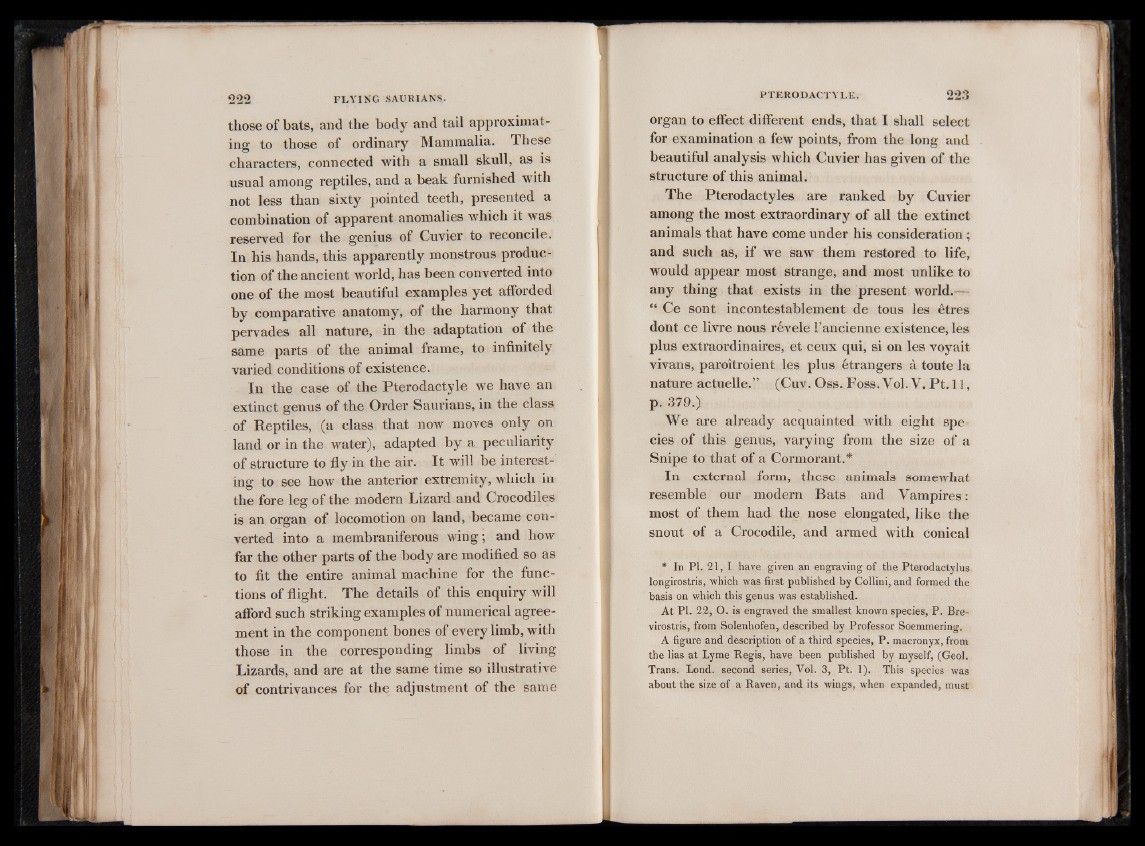
those of bats, and the body and tail approximating
to those of ordinary Mammalia. These
characters, connected with a small skull, as is
usual among reptiles, and a beak furnished with
not less than sixty pointed teeth, presented a
combination of apparent anomalies which it was
reserved for the genius of Cuvier to reconcile.
In his hands, this apparently monstrous production
of the ancient world, has been converted into
one of the most beautiful examples yet afforded
by comparative anatomy, of the harmony that
pervades all nature, in the adaptation of the
same parts of the animal frame, to infinitely
varied conditions of existence.
In the case of the Pterodactyle we have an
extinct genus of the Order Saurians, in the class
of Reptiles, (a class that now moves only on
land or in the water), adapted by a peculiarity
of structure to fly in the air. It will be interesting
to see how the anterior extremity, which in
the fore leg of the modern Lizard and Crocodiles
is an organ of locomotion on land, became converted
into a membraniferous wing; and how
far the other parts of the body are modified so as
to fit the entire animal machine for the functions
of flight. The details of this enquiry will
afford such striking examples of numerical agreement
in the component bones of every limb, with
those in the corresponding limbs of living
Lizards, and are at the same time so illustrative
of contrivances for the adjustment of the same
organ to effect different ends, that I shall select
for examination a few points, from the long and
beautiful analysis which Cuvier has given of the
structure of this animal.
The Ptérodactyles are ranked by Cuvier
among the most extraordinary of all the extinct
animals that have come under his consideration ;
and such as, if we saw them restored to life,
would appear most strange, and most unlike to
any thing that exists in the present world.—
“ Ce sont incontestablement de tous les êtres
dont ce livre nous révélé l’ancienne existence, les
plus extraordinaires, et ceux qui, si on les voyait
vivans, paroîtroient les plus étrangers à toute la
nature actuelle.” (Cuv. Oss. Foss.Yol.Y. Pt. 1 1,
p. 379.)
We are already acquainted with eight species
of this genus, varying from the size of a
Snipe to that of a Cormorant.*
In external form, these animals somewhat
resemble our modern Bats and Yampires :
most of them had the nose elongated, like the
snout of a Crocodile, and armed with conical
* In PI. 21, I have given an engraving of the Pterodactylus
longirostris, which was first published by Collini, and formed the
basis on which this genus was established.
At PI. 22, 0 . is engraved the smallest known species, P. Bre-
virostris, from Solenhofen, described by Professor Soemmering.
A figure and description of a third species, P. macronyx, from
the lias at Lyme Regis, have been published by myself, (Geol.
Trans. Lond. second series, Vol. 3, Pt. 1). This species was
about the size of a Raven, and its wings, when expanded, must